Kazuko Kobryn - Bio
Profile
KAZUKO "Kaz" KOBRYN (née Ishii) is a Japanese-American ethnomusicologist, linguist, and bon vivant. Kazuko, whose Japanese given name means "Child of Peace," developed her expertise in ethnomusicology under the guidance of the renowned pioneer of "World Music," Dr. Robert E. Brown. Her unwavering commitment enabled her to master a wide range of sophisticated musical instruments from around the world, including the Japanese koto, Indonesian gamelan gambang, and the Western piano. With her fluency in both English and Japanese, Kazuko has been able to utilize her linguistic talents as a professional translator and interpreter across four continents: North America, Europe, Asia, and Australia. Beyond her professional pursuits, Kazuko's vibrant interests encompass a passion for animals and gardening, as well as a fervent appreciation for international cuisine and fine wine, making her a true enthusiast of life's bounties.
Chronological Bio
Early Life: First Trimester
Kazuko, later known by her martial arts moniker "Fireball," was "born of fire" in 1943, amidst the flames of World War II, in Japanese-occupied Shanghai, China. The seeds of her life were sown by her parents, Kazuyoshi Ishii, a polyglot intelligence officer for the Japanese military and first-born son of a regional chieftain, and Fumiko Kikuchi, the youngest child of an aristocratic Hiroshima family. Kazuyoshi, an alumni of Tokyo Gaigodai, the Foreign Language University, was not only a master of his native Japanese but also adept in Chinese, English, and German. Humiko, on the other hand, was brought up following the onna-bugeisha tradition of female warriors, displaying proficiency in the arts of the Japanese koto, a 13-string plucked zither, and naginatajutsu, a form of spear fighting.
With the fortunes of war shifting rapidly in March 1945, Kazuko's father, in a bold move, decided to send his wife and toddler daughter on a perilous journey across enemy lines back to Japan. His hope was to shield them from the anticipated trials and tribulations following the imminent defeat of the Japanese forces in Shanghai. Despite facing numerous challenges, Fumiko and Kazuko managed to reach their home town of Onomichi, situated around 100 km (60 miles) southwest of Hiroshima.
Not long after their daring escape, on August 6, 1945, the two were in Onomichi when the "Little Boy" atomic bomb wreaked havoc on Hiroshima, leading to the loss and radiation-related illnesses of many of Kazuko's maternal relatives. Thus, even before reaching the age of three, Kazuko had experienced and survived two of World War II's major catastrophes: the downfall of Shanghai and the horrifying use of the first atomic bomb in warfare.
Although Kazuko was diagnosed with leukopenia, a condition characterized by a low white blood cell count, in her youth—likely a result of low-level atomic radiation exposure in 1945—she demonstrated remarkable physical prowess and agility throughout most of her life. As a child, she displayed academic brilliance, particularly shining in Japanese literature, calligraphy, piano, and gymnastics. Her extraordinary flexibility, demonstrated especially in her gymnastics performances, led to her nickname "Tako," meaning "octopus." In her formative years, Kazuko immersed herself in the practices of ninjutsu, the art of stealth, and tantojutsu, the art of knife-fighting. She continued to hone these martial arts skills well into her adulthood.
After completing high school, Kazuko pursued her passion for piano and classical music, especially Mozart, by enrolling at the prestigious Soeur Marie ("Sister Marie") Performing Arts Academy in Hiroshima. The academy, overseen by Belgian nuns and priests, proved to be a clash of values for the fiercely independent young woman who inherited her mother Fumiko's samurai spirit. Kazuko embraced a syncretic approach to religion, blending Buddhism, Shintoism, and Christianity, which conflicted with the academy's Catholic exclusivity and their insistence on primarily speaking French, a language unfamiliar to her. She had joined the academy to pursue her musical aspirations, but felt frustrated by the imposition of rigid Catholic doctrine and being coerced to speak a foreign language.
Middle Life: Second Trimester
Repressed and discontented, Kazuko rebelled against the academy and her parents' wishes and made the bold decision to leave the academy before receiving her diploma. Thanks to an empathetic and well-connected aunt in Yokohama, she secured employment within the local government and at an IBM office, where she first encountered nascent computer technologies during the early 1960s. It was in this period that she met and fell in love with Daniel M. White Sr., her first husband, who was a US Marine Sergeant serving in Japan during the Vietnam War. Despite initial resistance from her parents and Daniel's superiors, they married in 1964, leading to Kazuko's naturalization as a US citizen. The couple had three healthy children: Daniel M. White Jr., Diane M. White, and Dean M. White. Tragically, they lost another child due to a miscarriage, during which Kazuko experienced a severe health crisis and was temporarily pronounced dead due to massive blood loss. Daniel, a highly-decorated combat Marine, was quickly promoted to the rank of Gunnery Sergeant and was a nominee for Sergeant First Class. However, his promising Marine career and life ended prematurely due to a rare degenerative circulatory condition, likely a consequence of Daniel's exposure to the toxic defoliant, Agent Orange, during combat operations in Vietnam.
Instead of succumbing to self-pity as a young Marine widow with three small children in an unfamiliar country, Kazuko embraced her circumstances with courage. In the mid-1970s, she took the initiative and purchased a modest house in the rapidly-growing community of Vista, California, where she created a nurturing environment for her children, surrounded by vibrant plant life and a delightful array of pets, including dogs, cats, birds, and reptiles. Kazuko wholeheartedly immersed herself in the intensive study of music, English, and mathematics at a nearby community college, determined to broaden her knowledge and skills.
In 1977, Kazuko's life took a new turn as she crossed paths with Cris Kobryn, her future second husband. Cris was a US Marine Lieutenant stationed at nearby Camp Pendleton who was driven by his passion to master mixed martial arts before this concept was popularized. It was during this momentous encounter that they experienced an immediate and profound connection, igniting a love that would grow in separable. Their bond was marked by a mutual "coup de foudre" ("strike of lightning"), a transformative experience that solidified their union as soulmates. Kazuko and Cris embarked on a lifelong journey together, remaining deeply committed to each other not only in this earthly existence, but also in anticipation of their eternal spiritual connection "on the other side." Cris also committed to help Kazuko raise her fatherless children to the best of his abilities.
Kazuko's academic journey in music continued at San Diego State University (SDSU), where she studied music composition under the renowned composer Dr. David Ward-Steinman, and ethnomusicology under the godfather of "World Music", Dr. Robert E. Brown. As an ethnomusicologist Kazuko demonstrated mastery of two of the world's most challenging musical instruments: the Japanese koto (plucked zither with 13 strings) and Indonesian gamelan gambang (wooden xylophone with 17-21 keys). Under Dr. Brown's expert guidance Kazuko contributed a master's thesis in support of her graduate lecture recital: Tuning and Scale Systems of Ikuta School of Koto [Kobryn 1991]. (See PUBLICATIONS.) Her graduate lecture recital and thesis earned her the Master of Arts (MA) degree in Music from SDSU in 1991, and subsequent ethnomusicologists have referenced her groundbreaking work regarding the koto, which is Japan's national musical instrument.
Kazuko reflected on the circular path of her musical achievements in her master's thesis preface:
"This paper is the result of two years of research and practice on the thirteen-string Japanese koto. It brings to closure a circular path in my study of music. I began studying classical piano in Japan as a young child. Several decades later I find myself studying classical koto in the United States."
Kazuko first studied the koto under Yoko Ito Gates, a SDSU koto teacher and virtuoso who died prematurely and unexpectedly in 1989. Kazuko's second koto master was Hiromi Hashibe, who, along with Masakazu Yoshizawa, a renowned shakuhachi (bamboo flute) prodigy, accompanied her graduate recital lecture. Yohizawa later contributed to several notable Hollywood films, including "The Last Samurai".
Later Life: Third Trimester
In 2003, Kazuko and Cris jointly founded PivotPoint Technology Corp., a firm specializing in Model-Based Digital Engineering services, where Kazuko took on the essential role of the first Chief Financial Officer (CFO). The pair also made their unique mark on their two-acre residential property, whimsically dubbed "Rancho de Los Perros" ("Ranch of Dogs"), located in North San Diego County. They transformed the property into a park-like environment filled with a variety of trees and flowers, a rare feat in Southern California's dry climate, creating a sanctuary for their beloved pets, which included a large number of dogs, cats, reptiles, and various other animals.
As devoted grandparents, Kazuko and Cris have been steadfast in their support for their daughter Diane, a single mother, aiding her in raising her twins, Beth and Jayson. Impressively, Jayson and Beth not only skipped an academic year during grammar school, but they also graduated among the top of their high school class, with Jayson earning the additional distinction of valedictorian. They are currently pursuing their undergraduate studies at the University of California. Until recently, Kazuko maintained an active, vibrant presence at the local Senior Center, engaging daily in activities such as dancing, music, and bridge.
PUBLICATIONS
- [Kobryn 1991A] Kobryn, Kazuko. Tuning and Scale Systems of Ikuta School of Koto. Thesis in Support of a Graduate Lecture Recital, San Diego State University, Spring 1991.
- [Kobryn 1991B] Kobryn, Kazuko, April 2, 1991, Item 19, Box: 7, item: 19. School of Music and Dance Records, MS-0375. Special Collections & University Archives, San Diego State University.

